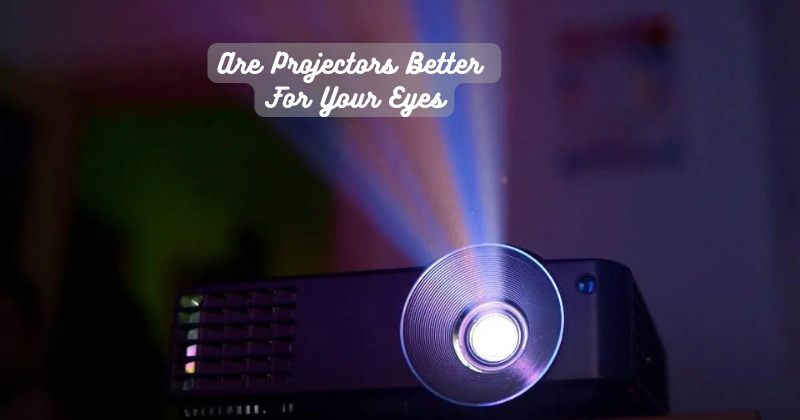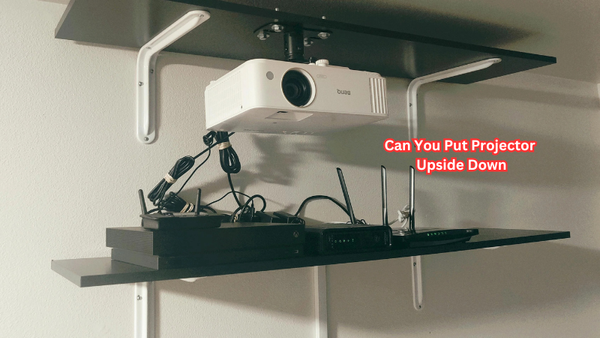Are projectors better for your eyes?
With the increasing use of technology in our daily lives, it's essential to consider the potential impact on our eye health. Projectors have become an alternative to traditional screens, offering larger and more immersive visuals.
Regarding eye health, projectors can be a better choice for several reasons. Firstly, projectors eliminate the need for staring at a small screen, reducing eye strain and fatigue. Projectors typically have adjustable brightness levels, allowing you to customize the display to your comfort. Their larger display size also promotes better viewing distances, minimizing eye strain.
So, considering using a projector may be a wise choice if you're concerned about your eye health. This guide will explore in more detail why projectors may be better for your eyes and provide some tips on using them effectively.
How Your Eyes Work
To understand why projectors may be better for your eyes, it's essential to first understand how your eyes work. The visual process is complex, but here are some key points to keep in mind:
- Our eyes have muscles that control the amount of light entering the eye through the pupil.
- The lens in our eye focuses light onto the retina at the back of the eye.
- The retina has photoreceptor cells that convert light into electrical signals, which are transmitted to the brain via the optic nerve.
- Our brain processes these signals to create the images we see.
The size and brightness of a screen or display can affect this visual process. For example, staring at a small screen for extended periods can cause strain on the muscles in our eyes, leading to headaches and fatigue. The brightness level can also impact the amount of light entering our eyes, which can cause discomfort or damage.
Avoid Blue Light Eye Damage
According to research, harmful blue light from electronic devices can cause eye damage. Projectors, however, typically use a color wheel or LED lights to create images, emitting significantly less blue light than traditional screens.
This lower level of harmful blue light can help reduce the risk of eye strain and long-term damage. Reflected light from a projector also tends to be softer than direct light from a screen, further decreasing eye strain.
If you choose to use a projector for extended periods, it's still essential to take regular breaks and practice the 20-20-20 rule (take a break every 20 minutes, look at something 20 feet away for 20 seconds).
Taking these precautions can help minimize any potential eye strain. Having undergone blue light adjustment therapy, wearing blue light-blocking glasses, or installing blue light filters on your devices can also be beneficial.
Why Projectors Are Better For Your Eyes
Now that we understand more about how your eyes work let's explore why projectors may be a better choice for your eye health.
Large Screen Display
One of the main advantages of projectors is their larger and more immersive display size. This allows for better viewing distances, meaning you can sit further away from the screen without sacrificing image quality. Sitting at an appropriate distance from the screen minimizes strain on your eye muscles, reducing fatigue and discomfort.
Adjustable Brightness Levels
Another benefit of projectors is their adjustable brightness levels. Most projectors have settings that allow you to customize the display's brightness, which can help reduce eye strain. This is especially helpful in dimly lit rooms where too much brightness can overwhelm our eyes.
Reduced Blue Light Exposure
Blue light is high-energy visible light emitted by electronic screens, including TVs and computer monitors. Overexposure to blue light can cause discomfort and potential damage to our eyes. Projectors often have lower levels of blue light emission than traditional screens, making them a healthier choice for our eyes.
Less Flickering
Flickering refers to the rapid changes in brightness levels on a screen. This can be caused by the screen's refresh rate, which is the number of times an image is redrawn per second. High refresh rates can lead to eye strain and headaches, especially for those sensitive to flickering. Projectors typically have lower refresh rates than other screens, making them a more comfortable option for our eyes.
Projector Vs. TV: Which Is Better For Your Eyes?
One of the primary concerns regarding eye health is exposure to blue light. Blue light is a high-energy and short-wavelength type of light that can cause strain on the eyes and disrupt sleep patterns. It's emitted from many electronic devices, including TVs and projectors.
However, there are significant differences in blue light exposure between projectors and TVs. Projectors typically emit less blue light than TVs, using a lamp or LED bulb to project the image onto the screen. These bulbs produce warmer and softer light compared to the harsher blue light emitted from LCD screens.
This means that using a projector may be better for your eyes when it comes to exposure to blue light. The projector eliminates harmful blue light with its softer and warmer lighting. Most advanced projectors diffused reflection imaging that reflects light towards the screen, which is easier on the eyes.
Another factor to consider is viewing distance. With TVs, we tend to sit closer to the screen, increasing the risk of eye strain and fatigue. In contrast, projectors are designed for larger viewing distances, providing a more comfortable viewing experience for your eyes.
The Benefits of Using a Projector
There are several benefits to using a projector instead of a traditional screen. Some of the most significant advantages include improved viewing experience, reduced eye strain, and increased versatility.
Improved Viewing Experience:
One advantage of using a projector is its ability to produce larger and more immersive visuals. Instead of squinting at a small screen, projectors can display images up to hundreds of inches in size, creating a more engaging viewing experience.
This is especially useful for presentations, movie nights, or gaming sessions. Diffuse reflection imaging makes the light softer, creating a more comfortable experience for our eyes.
Reduced Eye Strain:
As mentioned earlier, projectors eliminate the need for staring at a small screen, which can cause eye strain and fatigue.
By projecting the image onto a larger surface, your eyes can relax and focus on a more comfortable distance. Additionally, projectors typically have adjustable brightness levels, allowing you to dim the display to a comfortable level for your eyes.
Increased Versatility:
Projectors offer greater versatility than traditional screens as they can be used in various settings. They can be easily transported and set up in different locations, making them perfect for both personal and professional use. You can even use projectors outdoors for movie nights or presentations.
Tips for Using a Projector Effectively
To make the most out of your projector and protect your eyes, here are some tips to keep in mind:
- Keep the room well-lit: Ensure that the room in which you are using the projector is adequately lit. This will help reduce eye strain and ensure a clearer image.
- Take breaks: Just like with any screen, it's essential to take regular breaks when using a projector. Every 20 minutes, look away from the screen for at least 20 seconds, focusing on something in the distance.
- Adjust the focus and brightness: Make sure to adjust the focus and brightness of your projector to avoid any blurriness or discomfort for your eyes.
- Use a screen or wall: Instead of projecting onto a bare wall, try using a dedicated screen. This will provide a smoother and clearer image that is easier on the eyes.
With these tips in mind, you can enjoy all the benefits of using a projector while also prioritizing your eye health. Remember to take care of your eyes by using proper lighting, taking breaks, and adjusting settings for maximum comfort.
How Do Projectors Reduce Your Exposure to Blue Light?
Projectors typically use a lamp or LED bulb to project the image onto a surface. These bulbs emit warmer and softer light compared to the harsh blue light emitted from LCD screens. By using these types of bulbs, projectors can reduce your exposure to blue light, making them a healthier option for your eyes.
If you frequently watched LED screens, it is recommended to shift the projection mode, which reduces the exposure to blue light. Ambient light is emitted from projectors, meaning that it does not directly emit light into the eyes. Its visible light spectrum is more similar to natural light compared to traditional screens, making it easier on the eyes.
Additionally, projectors often have lower refresh rates compared to traditional screens, which can also contribute to reduced eye strain and fatigue. Overall, projectors offer a more comfortable viewing experience for our eyes, making them an excellent choice for those concerned about blue light exposure.
FAQs
Are projectors better than screens?
It depends on personal preference and intended use. Projector screens offer a larger and more immersive viewing experience, while traditional screens may be better for smaller, detailed images.
Is a projector better on a wall or screen?
While projectors can be used on both walls and screens, a dedicated screen often results in a clearer and more vibrant image. Projector screen and light source technology are designed to complement each other, resulting in a better viewing experience. However, if you have a smooth white wall available, it can also work well as a projection surface.
Are blue lights better for your eyes?
Blue light can have both positive and negative effects on our eyes. While it helps regulate our circadian rhythm, prolonged exposure to emitted light from screens can cause eye strain and fatigue. It's essential to limit emit blue light exposure, especially before bedtime. Using a projector can help reduce your overall exposure to blue light compared to traditional screens.
Conclusion
In conclusion, projectors can be better for your eyes than traditional screens. The larger display size of projectors allows for a more comfortable viewing experience, reducing eye strain and fatigue.
Projectors promote a healthier visual environment by eliminating the need to squint at small screens. Moreover, projectors often offer adjustable brightness levels, enabling you to customize the display to your preference and minimize eye discomfort.
With the ability to project onto larger surfaces, projectors also encourage appropriate viewing distances, reducing the risk of eye strain associated with close-up screen usage.
However, it's important to remember that proper lighting conditions and taking breaks from extended screen use remain crucial for maintaining good eye health. Consider incorporating a projector into your tech setup to prioritize your eyesight and enjoy a more immersive visual experience.





